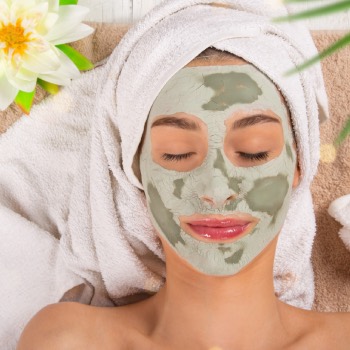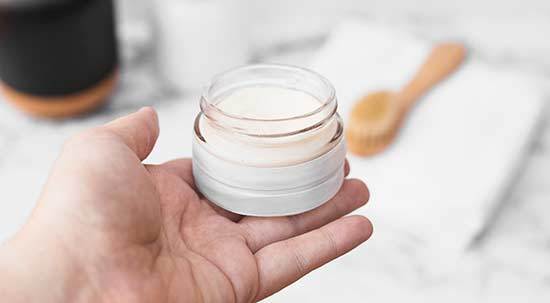A clay mask is something I just recently introduced into my skincare routine, and I have to tell you I'm loving it ever since! Before, applying a facial mask was something I thought men shouldn’t do (I know, weird right). As time went by I started to love it so much I began to wonder how often should you even use a clay face mask?
The most important factor in determining how frequently you should apply a clay mask is your SKIN TYPE. Different skin types will deal with the “stress” of using a clay face mask differently, so you need to be mindful of this fact to achieve maximum results. If you neglect this fact, you might not be quite satisfied with the outcome.
Your skin can fall under the category of oily/acne-prone, normal, combination, dry or mature.

How Often Should You Use A Clay Face Mask?
According to most skincare specialists, you should use a clay mask once or twice a week. If used more often, it can completely dry your skin out as it draws out oil as well as impurities. Remember that less is more and that you should not use a clay face mask more than two times per week (in most cases one day a week is more than enough!).
How Do Clay Masks Draw Out Impurities?
Clay masks have been used in cosmetics as face cleansers ever since the ancient times. There are various types of clay such as bentonite, French green clay, red, pink, Fuller’s Earth clay, Rhassoul clay, white kaolin clay, etc.
Probably the most famous sorts of clay are kaolin and bentonite. They also come in a range of colors. This is because clays, in general, are derived from silico-aluminum sedimentary rocks, and their coloration is dependent on the types of trace metals present and other ingredients.
Clay is hugely beneficial because it stimulates surface circulation. Not only do clay’s abundant minerals nourish the skin, but it also absorbs oil and toxins which in turn tightens and cleanses the face. Clay is also non-toxic and not a known allergen. You can choose between buying commercial clay face masks and making your own homemade one.
However, because commercial clay masks contain additional substances which may harm your skin, I would advise you to make your own because then you know exactly what goes in it. What’s more, pure clay is affordable while the price of these masks in stores can be expensive! So, you will probably save a few cents.
As for the time, you should let it sit on your face anywhere from 10 to 50 minutes. My recommendation is to remove it before it completely dries out because of its rapid effect. On average, it should last up to 15 minutes.
Can You Use Two Face Masks In One Day?
This is a tricky one, and the answer is both yes and no. Allow me to elaborate…
I recommend using two face masks in one day only if you have combination skin.
Use one type of clay mask to address the “T-zone” (your forehead, nose and sometimes the chin) and another one on your cheeks. Why?
Because the skin on your T-zone will usually be more oily and rugged, while the skin on your cheeks will look normal and healthy; so, essentially, it’s like having two skin types on your face at once, and those different skin types require a different skin care product.
Should You Cleanse Your Skin Before Using A Clay Face Mask?
Oops… at first, I didn’t know about this, and I would sometimes apply my face mask without cleansing my skin thinking “it’s the clay mask’s job to do that for me.”
But if you think about it, it makes perfect sense because otherwise, you’d just be placing the mask on top of all sorts of dirt, debris, and bacteria.
Note that I am not talking about an intense scrub (or using an exfoliator); all you need is a few gentle strokes with a gentle cleanser, just to remove the excess oil, dirt, and traces of makeup. You can also steam your face to open up the pores and allow the mask to do its job better.
I say you can, but if you want to experience the full benefits of this skin treatment, you should steam your skin first.
How Many Times A Week Should I Use A Face Mask?
I already said that how often you use a clay face mask will depend on your skin type:
• Oily/Acne Prone Skin – oily skin is a bit tougher and can “take a beating” so you are free to use a facial mask two to three times per week (you really shouldn’t go over three times per week, and I get good results even from using it once a week).
• Normal Skin Type – even if you have perfect complexion and flawless skin, a clay face mask will still be beneficial, and you should use it two to three times per month.
• Dry/Mature Skin Type – dry skin is a bit more sensitive, so I would not recommend using the mask more than once a week.
• Combination Skin Type – I already said that, if you have combination skin type, you should use two different face masks but make sure you use them no more than once a week.
How Often You Should Use A Clay Face Mask – Different Skin Types

As I said at the beginning of the article, how many times a week/month you use a facial clay mask will depend on your skin type. These are the most common skin types:
Oily/ Acne-Prone Skin
If you have oily skin and struggle with zits and acne scars, a clay face mask should be incorporated into your skincare routine. But you shouldn’t use it more than three times per week; I use it only once every week and see great results.
My skin is oily and a bit rugged, and if your skin is the same I would recommend using red kaolin and Fuller's Earth clay because they have the highest oil absorbing power. And if your skin is both oily and sensitive, you should go with pink kaolin clay by mixing red and white kaolin clay for a well-balanced treatment.
Here’s an example mask you can mix up at home for your oily skin:
Aromatherapy Clay/Witch Hazel Mask:
To make:
- 1Mix 1tbsp. of clay with 1tsp. aloe vera juice, 1tsp. witch hazeland enough water to make a paste
- 2Add 1 drop of essential oil ortea tree
- 31 drop of essential oil of lavender and 1 drop of essentialoil of peppermint
To use:
apply to clean skin for 15mins. Rinse with warm water and follow with a cool water splash.
Normal Skin Type
Though normal skin is the most favorable and won’t cause any significant problems, applying a clay mask can still be beneficial for you, in that it will cleanse, refine and soften your face. But since they are slightly drying, make sure you use it only twice a month.
Suggested clay mask recipe for a normal skin type:
- 1Two parts magnesium and one part calamine
- 2Mix with rosewater to form a smooth paste
- 3Kaolin may be added if there are blemishes present or congestion under the skin
Dry/Mature Skin
If your skin is dry and sensitive, you need to be extra careful when choosing a clay mask for your face.
One neat trick you can try is applying oil to the skin prior to clay to avoid the adverse drying effect. Apply sweet almond, grapeseed or apricot kernel oil first and then a clay mask over it (without removing the oil).
And if you’re in the mood for pampering yourself (as you would be if in a spa), you could add additional ingredients like milk, honey, powdered oatmeal, crushed herbs or cocoa powder and feel like a king/queen!
Your best choice for sensitive skin would probably be white kaolin clay since it is the mildest variety which gently exfoliates, softens and moisturizes your skin. Still, don’t use it more than twice a week for a maximum of 15 minutes (I would even bring this down to once a week).
One dry skin recipe you can try is Aromatherapy Rejuvenating Mask:
To make:
- 1Mix 1tsp of facial-quality clay, 1 tsp of instant oatmealor oat flour
- 21/2 tbsp powdered milk, 1tsp honey, 1tsp avocadoor olive oil and enough water to make a paste
- 3Add one drop of essential oilof frankincense and one drop of essential oil of neroli, lavender oor rose
To use:
Apply to clean skin for 10 mins. Rinse with warm water and follow with a cool-water splash.
Combination Skin
Combination skin, though not the toughest one to deal with, comes with its unique set of challenges since you basically have two skin types present at the same time.
For this reason, you should consider using more than one mask at a time. First, apply your clay mask to the area which needs more treatment (oily T-zone) and let it sit on your skin longer. Then, apply the other mask to the rest of your face (primarily cheeks).
Remove both masks at the same time and do not use it more than once a week.
You might like the following recipe:
Clay Cleanser (for normal, oily or combination skin)
To make:
Mix 4tbsp. of clay, and 1 tbsp. each of powdered lavender and comfrey leaf.
To use:
Mix approximately 1tbsp of the clay-and-herbs mixture with enough water to make a paste. Gently apply to the face and neck with a light massage. Rinse with warm water followed by a cool water splash.
Optional: Add 2 drops of essential oil of geranium, ylang-ylang, or rosewood when you mix the dry blend with water.
How Often Should You Use Different Types Of Clay Face Masks?
Bentonite Clay
Bentonite clay is actually sourced from volcanic ashes! Despite its “brutal” origins, its effect on the skin is surprisingly mild. It is mostly used to draw out impurities and cleanse the skin.
The clay is commonly used for both face and hair masks as it offers deep moisture.
As for usage, you should use it no more often than once a week. In extreme cases (in people with overly dry skin), it is recommended to use it two times per week, but this is a bit extreme for most people.
Fuller’s Face Clay
Fuller’s Earth, also known as Multani Mitti in India, is a special type of clay that is highly beneficial to our skin as it contains abundant helpful ingredients.
This is why it has been used for many years for pores tightening, exfoliation, restoring youthful look, and acne and pimple prevention.
Due to its beneficial effects, you might be tempted to use it daily, but the recommended amount is once or twice per week.
Kaolin Clay
Kaolin clay is also known as white clay or China clay, and it is most widely used because it’s the mildest of them all. Because the clay is so mild, it’s been used for many different products but also for all skin types.
It penetrates deeply into the skin while flushing out dirt from the pores and removing excess oils.
So, should you use it daily?
Because this clay is so mild, you can use it more often than others we’ve already mentioned. Depending on your skin type, you can use a kaolin clay face mask 2 or even three times per week for optimal results.
French Green Clay
French Green clay is, as the name suggests, naturally found in France (the Montmorillonite region, to be more precise). It’s made of kelp seaweed and iron oxides, hence the greenish color.
It contains magnesium, calcium, potassium, selenium, cobalt, and many other minerals, making it perfect for the raw material in the skin industry.
Now, you need to make sure not to use this face clay too often as it might dry out your skin. It is best to use it only once a week, but if you have sensitive skin, it might be a good idea to remove it from your skin regimen altogether.
Rhassoul Clay
Rhassoul clay is found only in the mountains of Morocco, which is why it’s also sometimes called Moroccan red clay.
One of the most fascinating facts about this clay is it's full of metallic elements that carry a negative charge. Once we apply it to the skin, the negatively charged clay attracts positively charged toxins and allows you to wash them away while rinsing it!
You should use this clay in the form of a face mask no more than once a week. But if you’d like to use it as a face wash, you are free to do so every day as long as you mix it with water.
The Right Time Of Year For Your Face Mask
Another important thing to consider when deciding how often you should use a clay face mask is the WEATHER/TIME OF THE YEAR. Regardless of your skin type, in the summer you want to use face masks less often since the sun will already dry your skin out.
If you are buying a mask, look for one with hyaluronic acid or alpha hydroxy acid (AHA) to hydrate your skin.
In a nutshell, to get the most out of your clay face mask use it from twice a month to twice a week for up to 15 minutes depending on your skin type and adjust your routine depending on the season.
References:
• Natural Skin Care by Joni Loughran
• Natural Beauty Basics: Create Your Own Cosmetics and Body Care Products by Dorie Byers
• Chemical Composition of Everyday Products by John Toedt, Darrell Koza, Kathleen Van Cleef-Toedt
• Beauty Therapy Fact File by Susan Cressy
• A Practical Guide to Beauty Therapy for NVQ Level 2 by Janet Simms
• 200 Tips, Techniques, and Recipes for Natural Beauty by Shannon Buck
• https://www.dermveda.com/articles/science-of-facial-masks-and-facial-clay











